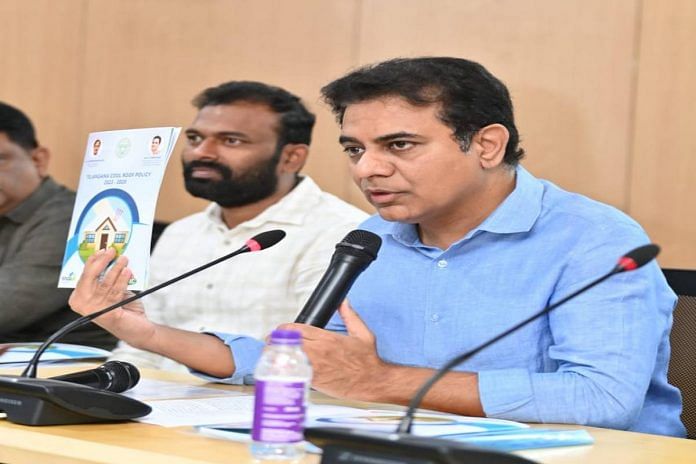Hyderabad: In what is being called a first for India, the Telangana government launched a ‘cool roof’ policy Monday to help provide a cost-effective and climate-friendly solution to escalating temperatures caused by rampant urbanisation.
Under the policy, government, commercial, and residential buildings in the state will be required, in a phased manner, to adopt cool roofs. These use materials that reflect sunlight and absorb less heat, reducing a building’s overall temperature and lowering energy consumption due to air conditioners and so on.
The Telangana Cool Roofs Policy 2023-2028 was launched in Hyderabad by IT and municipal administration minister K.T. Rama Rao (KTR), who said he hoped the state would become a “role model” to others.
Speaking to mediapersons Monday, KTR said the measure would “build resilience against extreme heat, improve thermal comfort, and move the state towards reducing urban heat islands in its cities”.
The urban heat island effect refers to a phenomenon where highly urbanised areas experience higher temperatures than surrounding regions.
Such ‘islands’ form since built surfaces like roads and rooftops tend to absorb and retain more heat than natural surfaces. Other than higher temperatures and related illnesses, heat islands are also associated with poor air quality and higher energy consumption due to the use of fans and ACs, which further add to greenhouse gas emissions.
“Climate change is making extreme events such as heat waves more severe and frequent… Telangana, being in the Deccan Plateau, is vulnerable to heat waves due to its geographical and topographical content. Telangana is on a high growth trajectory with rapid urbanisation, increasing the demand for cooling,” the policy statement says.
Here is a look at how cool roofs work and how the policy is expected to be rolled out in Telangana.
Also read: ‘Underfunded, not built for local context’: Think tank CPR on heat action plans of 18 Indian states
What is a cool roof?
‘Cool roofs’ have gained traction as a tool that can help mitigate the urban heat island effect and reduce energy consumption, studies show.
These roofs are designed to absorb less sunlight than regular roofs, thus reducing heat retention in buildings and lowering the requirement for artificial cooling inside.
Cool roofs reflect up to 80 per cent of sunlight, compared to only 20 per cent by regular roofs, and can lower indoor temperatures by as much as 2.1 to 4.3 degrees Celsius, the policy says.
Installing a cool roof is a fairly simple and cost-effective exercise. It involves coating a building’s existing rooftop with solar-reflective paint or using specialised tiles and sheet membranes, among other materials that effectively reflect sun rays.
In his media address Monday, KTR also emphasised that installing a cool roof was not a very difficult task. “As a first step, I got my house roof painted in white,” he said.
How will cool roof policy be executed?
The Telangana cool roof policy will be rolled out in a phased manner, starting with converting the roofs in 300 square kilometres of the state (of which 200 sq km will be in Hyderabad) by 2028-29.
The first target in this phase is to institute cool roofs in a 5 sq km area of Hyderabad in 2023-2024.
The policy document estimates that implementing the first phase could save up to 600 million units (GwH) of energy annually and a “one-time carbon offset of 30 million tCo2” — in other words, a reduction of 30 million metric tonnes of Co2 emissions.
“Our target till 2028-2029 is to cover 200 square kilometres of Hyderabad under cool roofs, that is literally 20 per cent of the area within the outer ring road limits,” KTR said at the Monday press conference.
The Telangana policy, which currently outlines only the first phase, mandates that all government buildings, non-residential complexes — such as hotels, shops, theatres, retail complexes, hospitals, and educational institutions — and residential properties occupying more than 600 square yards must adopt cool roofing by 2028-29
Government housing for Economically Weaker Sections will also have cool roofs. Retrofitting of all non-residential buildings is expected to be done in the next three years.
To achieve the policy’s goals, relevant departments will create a framework to educate citizens and provide training programmes for installing cool roofs.
A clause for mandatory cool roofing will also be incorporated in Telangana state building permission approval systems.
“This policy is not a short-term goal, neither is it launched aiming at any voters. It is a long-term goal and an attempt to give our future generations a better life. Hyderabad had the highest office space absorption in the country in 2022, more than Pune and Bengaluru and successful implementation of the policy could make Telangana a role model for the country,” KTR said.
He noted also how Hyderabad has followed in the footsteps of US cities such as New York and Los Angeles, which have adopted cool roof solutions. The Greater Hyderabad Municipal Corporation had initiated a pilot cool roof programme in 2017.
Notably, the central government went on to release the ‘India Cooling Action Plan’ in 2019, focussing on similar measures.
(Edited by Asavari Singh)



